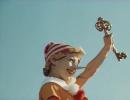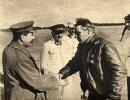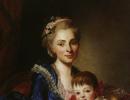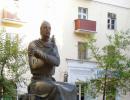Neskuchny garden aviary with animals. In the animal world. Sights of Neskuchny Garden Park
Neskuchny Garden Park is a green area 6.5 km long, located near the center of Moscow. The territory of the complex occupies 60 hectares of land along the right bank of the Moscow River. This is one of the oldest parks in the city, preserved from the Neskuchnoye noble estate.
Neskuchny Garden complex: history of appearance
The current territory of Neskuchny Garden in the mid-18th century belonged to three nobles - Trubetskoy, Golitsyn and Demidov. Their estates were located on the banks of the Moscow River and were famous for their well-equipped palaces, parks and gardens.

The Golitsyns' possessions were located in the very center. Trubetskoy’s estate was famous for its “Neskuchny country house”, where entertaining evenings were often held. A garden with gazebos was laid out on the territory, and bridges were thrown across the streams. No less famous was the estate of Prokofy Demidov, or rather the botanical garden he created in the form of an amphitheater. On the terraces there were winter and summer greenhouses with many species of exotic plants, and rare species of birds and animals lived near the ponds.

From the 1820s to the 1840s, by decree of Nicholas I, all the estates that now cover the territory of Neskuchny Garden were purchased one by one. The royal summer residence became the Neskuchnoye estate, this name was preserved from Trubetskoy’s country house. The territory began to be redeveloped, but most of the buildings remained in their places. The Demidov Palace became the central imperial residence and was renamed the Alexandria Palace.
The estate was in the palace department until 1917, and after that it was nationalized and became available to the people. In 1928, Neskuchny Garden was included in the park named after. Gorky - new alleys, platforms and pavilions were completed.
Sights of Neskuchny Garden Park
Walking through the picturesque park, you can admire the abundance of flowers and trees, walk along alleys and bridges across ravines.

The main road in Neskuchny Garden leads to Pushkinskaya Embankment, where there is a pier for ships.

The park has rides for kids, a Children's Equestrian School, and a variety of sports grounds. In addition, here you can get acquainted with cultural heritage sites:
Hunting lodge of the Trubetskoy estate built in the mid-18th century. It is known to Muscovites and guests of the capital because since 1990 the popular TV show “What? Where? When?".

Alexandria Palace(now the building of the Academy of Sciences), which is reached by a road from the main entrance gate of the 19th century. In the palace itself, the pre-revolutionary interior and sculptures “The Seasons” by I. P. Vitali have been preserved.

Summer house of Count Orlov- the oldest building in Neskuchny Garden. Nowadays there is a library here.

Rotunda-gazebo in honor of the 800th anniversary of Moscow, built in 1947. It depicts important events in the history of the city, starting from the founding of Moscow and ending with the Victory Parade in 1945.

There is a park nearby and "Alley of Love".

Green Theater used as a venue for concerts. It can accommodate up to 15,000 spectators.

On the territory of the Neskuchny Garden complex there is Mineralogical Museum- one of the largest in the world. The collection contains samples of minerals from Russia and foreign countries.
Do you think that you can only see a moose or a raccoon in their natural habitat outside the city, and in Moscow the only living creatures left are pigeons? This is one of the most common misconceptions among Muscovites, who often do not even know that more than a third of the territory within the Moscow Ring Road is occupied by parks, nature reserves, shady boulevards and squares. And not only people, but also animals feel comfortable there.

In Sokolniki there are moose
Sokolniki Park is one of the most populated with natural inhabitants, especially considering its proximity to national reserve"Elk Island" Together with it they form a huge green space stretching into the Moscow region.
If you come to Sokolniki and go deep into the park, you may well meet a moose - they sometimes wander into the park from the reserve, although they prefer not to have contact with people. If you want to be guaranteed to see this horned animal, then it is better to go to the Elk Biological Station - it is located not far beyond the Moscow Ring Road, but getting there is not so easy. But the most patient will be able to see and communicate with live moose and moose calves. Before your visit, you need to make an appointment; details are on the reserve’s website, elkisland.ru.
However, the territory of Sokolniki itself also offers fauna lovers a lot of interesting things. You can easily spot snakes, frogs, squirrels and rare birds, including the white-backed woodpecker, shrike, long-eared owl and others. If you have a weakness for birds, then you should definitely go to the ornitarium - there are all year round treated and rehabilitated. “Everyone can, without leaving the urban environment, see in close proximity rare species of birds, many of which cannot be released into the wild for a number of reasons. Currently, more than 130 birds are on display,” the ornitarium says. You can easily get there on foot from the main entrance following the signs or by asking the security for directions.
If you come to Sokolniki and go deep into the park, you may very well meet a moose
In addition, a petting zoo has recently opened in the park - there you can get acquainted with a variety of animals and even feed them. Among the inhabitants of the zoo are chinchillas, raccoons, rabbits, guinea pigs, dwarf sheep, parrots, guinea fowl, foxes, goats and hedgehogs.
The zoo is also located not far from the main entrance to the park - on the right, behind the Falconry restaurant.
At VDNKh - killer whales
Another space where representatives of the animal world live is VDNKh and its adjacent Botanical Garden and Ostankino Park. In addition to the usual squirrels and various birds found in almost every park, there are also unusual animals.
In search of them, you should first go to the “urban farm”. Indian zebu cows (a whole family), the Nubian goat Boris and Nubian goats, ordinary sheep and polled fat-tailed sheep, as well as new settlers - raccoons and alpacas live there. The latter were presented to the general public only last weekend. There is also a rabbitry, a pen with donkeys and a poultry yard with geese and ducks.
You can feed the animals by first purchasing food from the vending machines.
Nearby, in pavilion 48 called “Sheep Breeding”, there is, oddly enough, a city equestrian center where experienced trainers teach all areas of equestrian sports.
The center also provides services for one-time rides on horses, donkeys and ponies, the VDNKh administration says. - Every day from 10.00 to 20.00 there are excursions around the stables, where children and adults are told about the breeds, colors of horses, types of equestrian sports, as well as interesting stories from the life of those horses that stand in our stable. During the excursion, those interested can try to ride a pony, of course, under the guidance of a trainer-guide, and also admire the Akhal-Teke horse (Ahal-Teke horse) of a rare black color.
And, of course, don’t forget about the Moskvarium aquarium. In the area of his aquarium with a total area of 12 thousand square meters. m live 8 thousand marine and freshwater inhabitants from all over the world. There are even killer whales and walruses, and there is also a swimming center with dolphins.
Pheasants in Gorky Park
Gorky Park will not surprise you with an encounter with moose or other animals rare for Moscow, but you will still be able to communicate with representatives of the fauna there. For example, pheasants live here, and there are three species at once. There are two pheasantries in Neskuchny Garden and one more in the central part of the park opposite the Golitsynsky Pond. “There, near the Golitsyn Ponds, near the Ostrovok cafe and the children’s playground, there is an aviary with rabbits. White and black swans and two geese live on the large and small Golitsyn Ponds,” say the park’s management.
There is also a “green school” here, where children are taught gardening, carpentry and pottery, biology and psychology. Children at school can chat with rabbits, feed aquatic red-eared turtles and parrots - 2 cockatiels and 6 wavy ones live here, as well as 3 giant Achatina snails.
One of the favorite pastimes of park guests is feeding squirrels and ducks. You can bring nuts first; they must be fresh, unroasted and unsalted. The feathered inhabitants of the Golitsyn ponds only need to crumble the bread, and the rabbits will be delighted with raw vegetables - cabbage, carrots, potatoes, pumpkin. “As with any animals, you need to communicate with the inhabitants of the park carefully - do not grab them, do not frighten them or cause discomfort. All our animals are vaccinated,” the park warns.
In "Kolomenskoye" - falcons
In fact, you can see some kind of wildlife in any park in the capital, at least it will be squirrels and birds. In the Kolomenskoye Museum-Reserve, for example, there is a huge variety of birds - the goshawk, the long-eared owl, the corncrake, the common spotted woodpecker, the common shrike and others live there. The Falcon Yard complex, where the exhibition “Falconry of Tsar Alexei Mikhailovich” operates, has also been recreated on the territory of the museum. It is dedicated to the centuries-old tradition of Russian princes and tsars - falconry, which reached its peak in Russia during the reign of Alexei Mikhailovich. Birds of prey (saker falcons and goshawks) live there in enclosures.
In Kuzminki Park you can even meet hares and foxes, as well as a huge number of squirrels - they are easy to find in the squirrel forest. You can photograph the animals there, feed them, or just watch them. There is also an equestrian club with a petting zoo nearby.
In the Fili park, with some luck and the desire to go to remote places, you will be able to see red-listed shrews, bats, hedgehogs, brown hares and others.
“Walking near the ponds, streams and swamps of our ancient park, you may still meet an ordinary newt or a grass frog flash under your feet, or maybe even the so-called sharp-faced frog. All these species of reptiles are listed in the Red Book of Moscow, and their numbers are constantly declining ", say the park administration.
In other green areas of the capital, especially large ones, animal world also boasts variety.
By the way
Launched in Moscow social network for dating in parks - with its help you can find a travel companion for going to the movies or going on a bike ride together. Just download mobile app ParkSeason on your phone. The social network is already being tested in Sokolniki Park. By logging into the application, users see which social network members are nearby.

Infographics: "RG"/Anton Perepletchikov/RIA Novosti
Reindeer have settled in Neskuchny Garden. The animals were delivered from a private nursery near Moscow. Their appearance has already aroused keen interest among visitors - you can talk to the deer and even feed them apples. But for now the young couple is settling into a new place and getting used to a new star life.
The worst thing - the road - is behind them. One-year-old fawns - a female and a male - were brought to Neskuchny Garden from a nursery near Moscow. The journey took about two hours, and according to transportation rules, the animals had to be euthanized during this time.
“These animals are very playful and restless. So that they do not injure themselves is the first thing, and during transportation, so that no problems arise, because they can break their legs,” says Maria Kazankina, head of the zoo section of the sports and leisure department Gorky Central Park of Culture and Culture.
The female was the first to come to after a deep sleep. Waking up in an enclosure surrounded by a dozen people watching her, she became embarrassed and nervous. After all, not only is there an unfamiliar environment around, but these animals are not used to such increased attention.
The couple haven't yet come up with names. Park employees plan to announce a competition among visitors.
IN wildlife reindeer eat moss. In the central zone, this is, of course, a problem, but this will not make the animals’ diet poorer. They will be given feed and hay, and visitors will be allowed to feed them apples.
However, now, due to stress, the deer do not touch food. This is temporary, zoologists say. In a good way, silence would be necessary to get used to the place, but visitors to the park cannot calmly pass by the inhabitants of the menagerie. They are discussing that these deer are very different from the northern ones. It turned out that this pair - from a domesticated species - comes from Southern Siberia. Therefore, different sizes and colors. But the husky dog sensed the native northern blood. She broke off the leash and rushed off to meet her fellow countryman.
The enclosure in which the deer now live appeared here a couple of years ago. Sheep used to live here. Now they have been sent to the Moscow region for the winter. They will be returned in the spring - they plan to expand the enclosures and create a mini-zoo in Neskuchny Garden.

“We hope that Neskuchny Garden, as well as the ground part of Gorky Park, will become a natural habitat where people will come not only to read a book, dance, play, but also to get in touch with nature. Few parks can meet such individuals, especially moreover, they are so cute,” says Irina Alekseeva, PR director of the Gorky Central Park of Culture and Culture.
According to zoologists, it will take several days for the deer to feel at home in Neskuchny Garden. Over the winter, the couple will settle down, and in the near future, experts expect a new addition to the family.
Based on materials from mosday.ru






